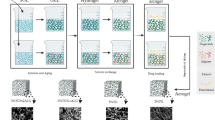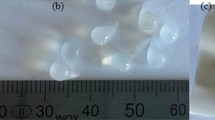Abstract
There are a lot of synthetic polymers which can be used for controlled drug delivery, however they are not easily accepted by the organism. Also incorporation of drugs into carriers runs under difficult conditions. Therefore scientists have been inclined to use natural-origin polymers, such as proteins and polysaccharides. Some of these promising natural polysaccharidic candidates are alginic acid sodium salt, guar gum and chitosan due to their outstanding merits. They are similar to extracellular matrix having high chemical versatility, good biological performance and cell or enzyme-controlled degradability. Many polysaccharidic hydrogels for drug delivery have already been prepared, but one of their weakness is their short life in dry air conditions; thus, special coating materials are being developed for enhancing their life time.
Alginates were used in the present research for synthesis of organic biodegradable gels by sol-gel process, which were further easily converted to aerogels by supercritical drying. They are safe for use, nontoxic, and derived from renewable sources. Aerogels made of alginate are dry and stable materials, which makes them interesting as a substitute to hydrogels. Alginates undergo reversible gelation in aqueous solution through interaction with divalent cations such as Ca2+, which create ionic inter-chain bridges. Two fundamental methods of ionic cross-linking were used to prepare alginate hydrogels: the diffusion method, where spheres are created and the internal setting method resulting in monoliths. After producing the hydrogel, alcogels were formed by solvent exchange using 100% ethanol. Ethanol was later replaced by supercritical CO2 with supercritical drying (100 bar, 35°C). Aerogels made from natural polysaccharides combine both biocharacteristics and aerogel characteristics such as high porosity and specific surface area, which makes them really attractive in drug delivery applications. The aerogels obtained in present research were therefore studied as drug carriers. The effects of the alginate composition and synthesis method on model drug nicotinic acid release were investigated. The results indicated that by using the internal setting cross-linking method for obtaining aerogels nicotinic acid was released in a more controlled manner. That is why further investigation was done on alginate spherical beads for prolonging their drug release. A multi-step sol-gel process was applied to generate complex aerogels with multi-membranes. First ionically cross-linked spherical cores were obtained by dropwise addition of sodium alginate solution into a CaCl2 solution. These cores were further immersed into alginate solution, filtered through a sieve and dropped into a salt solution again. By repeating the above process, different multi-membrane hydrogels were produced and further converted to aerogels. By adding more membranes around core burst drug release was successfully inhibited.
Similar content being viewed by others
References
P. Malafaya, G. Silva, R. Reis, Advanced Drug Delivery Reviews 59, 207 (2007).
Z. Novak, Knez, Ž., Journal of Non-Crystalline Solids 221, 163 (1997).
Z. Liu, Y. Jiao, Y. Wang, Advanced Drug Delivery Reviews 60, 1650 (2008).
S. Patil, Pharmaceutical Reviews E-journal, 2008.
H. Akhondi, E. Taheri-Nassaj, H. Sarpoolaky, Ceramics International 35, 1033 (2009).
Raluca Horga, Francesco Di Renzo and Françoise Quignard, Applied Catalysis A: General 325, 251 (2007).
F. Onofre, Y. Wang, A. Mauromoustakos, Carbohydrate Polymers 76, 541 (2009).
E. Cefali, D. Bova U.S. Patent 6818229, filed October 31, 1997, and issued November 16, 2004.
Author information
Authors and Affiliations
Rights and permissions
About this article
Cite this article
Veronovski, A., Novak, Z. & Željko, K. Organic Biodegradable Aerogels Used in Controlled Drug Release. MRS Online Proceedings Library 1306, 702 (2011). https://doi.org/10.1557/opl.2011.315
Published:
DOI: https://doi.org/10.1557/opl.2011.315




